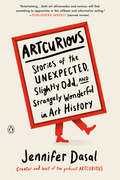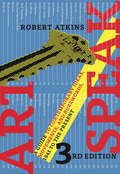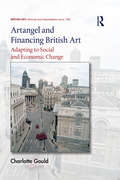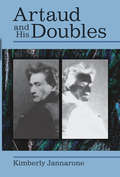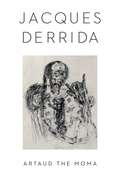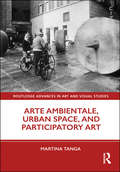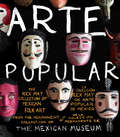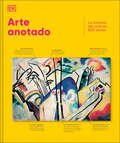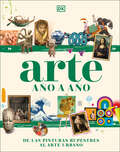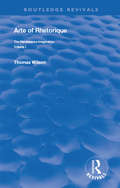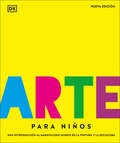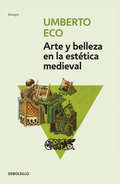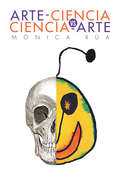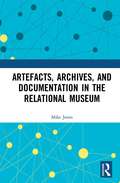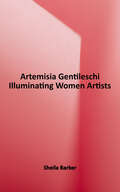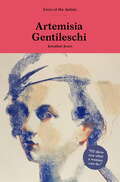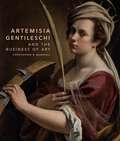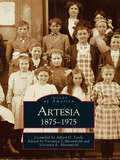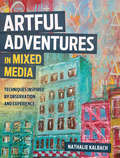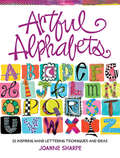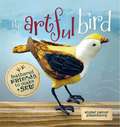- Table View
- List View
Art: Inside a Socially Situated Practice (Routledge Advances in Art and Visual Studies)
by Loraine LeesonThis book brings a practitioner’s insight to bear on socially situated art practice through a first-hand glimpse into the development, organisation and delivery of art projects with social agendas. Issues examined include the artist’s role in building creative frameworks, the relationship of collaboration to participation, management of collective input, and wider repercussions of the ways that projects are instigated, negotiated and funded. The book contributes to ongoing debates on ethics/aesthetics for art initiatives where process, product and social relations are integral to the mix, and addresses issues of practical functionality in relation to social outcome.
ArtCurious: Stories of the Unexpected, Slightly Odd, and Strangely Wonderful in Art History
by Jennifer DasalA wildly entertaining and surprisingly educational dive into art history as you've never seen it before, from the host of the beloved ArtCurious podcastWe're all familiar with the works of Claude Monet, thanks in no small part to the ubiquitous reproductions of his water lilies on umbrellas, handbags, scarves, and dorm-room posters. But did you also know that Monet and his cohort were trailblazing rebels whose works were originally deemed unbelievably ugly and vulgar? And while you probably know the tale of Vincent van Gogh's suicide, you may not be aware that there's pretty compelling evidence that the artist didn't die by his own hand but was accidentally killed--or even murdered. Or how about the fact that one of Andy Warhol's most enduring legacies involves Caroline Kennedy's moldy birthday cake and a collection of toenail clippings?ArtCurious is a colorful look at the world of art history, revealing some of the strangest, funniest, and most fascinating stories behind the world's great artists and masterpieces. Through these and other incredible, weird, and wonderful tales, ArtCurious presents an engaging look at why art history is, and continues to be, a riveting and relevant world to explore.
ArtSpeak: A Guide To Contemporary Ideas, Movements, And Buzzwords, 1945 To The Present (G - Reference,information And Interdisciplinary Subjects Ser.)
by Robert AtkinsThe leading lexicon of contemporary art returns in an expanded, full-color third edition and is now available for the first time as an ebook.An indispensable guide for art-world neophytes and seasoned professionals alike, the best-selling ArtSpeak returns in a revised and expanded third edition, illustrated in full color. Nearly 150 alphabetical entries-30 of them new to this edition-explain the who, what, where, and when of postwar and contemporary art. These concise mini-essays on the key terms of the art world are written with wit and common sense by veteran critic Robert Atkins. More than eighty images, most in color, illustrate key works of the art movements discussed, making ArtSpeak a visual reference, as well as a textual one. A timeline traces world and art-world events from 1945 to the present day, and a single-page ArtChart provides a handy overview of the major art movements in that period.
Artangel and Financing British Art: Adapting to Social and Economic Change (British Art: Histories and Interpretations since 1700)
by Charlotte GouldThe Artangel Trust has been credited with providing artists with all the money and logistics they need to create one-off dream projects. An independent art commissioning agency based in London, it has operated since 1985 and is responsible for producing some of the most striking ephemeral and site-specific artworks of the last decades, from Rachel Whiteread’s House to Jeremy Deller’s The Battle of Orgreave. Artangel’s existence spans three decades, which now form a coherent whole in terms of both art historical and political periodisation. It was launched as a reaction to the cuts in funding for the visual arts introduced by the Thatcher government in 1979 and has since adapted in a distinctive way to changing cultural policies. Its mixed economic model, the recourse to public, private and corporate funds, is the result of the more general hybridisation of funding encouraged by successive governments since the 1980s and offers a contemporary case study on broader questions concerning the specificities of British art patronage. This book aims to demonstrate that the singular way its directors have responded to the vagaries of public funding and harnessed new national attitudes to philanthropy has created a sustainable independent model, but also that it has been reflected more formally, in their approach to site. The locational art produced by the agency has indeed mirrored new distinctions between public and private spaces, it has reflected the social and economic changes the country has gone through and accompanied the new cultural geographies shaping London and the United Kingdom. Looking into whether their funding model might have had a formal incidence on the art they helped produce and on its relation to notions of publicness and privacy, the study of Artangel gives a fresh insight into new trends in British site-specific art.
Artaud and His Doubles
by Kimberly JannaroneArtaud and His Doublesis a radical re-thinking of one of the most influential theater figures of the twentieth century. Placing Artaud's writing within the specific context of European political, theatrical, and intellectual history, the book reveals Artaud's affinities with a disturbing array of anti-intellectual and reactionary writers and artists whose ranks swelled catastrophically between the wars in Western Europe. Kimberly Jannarone shows that Artaud's work reveals two sets of doubles: one, a body of peculiarly persistent received interpretations from the American experimental theater and French post-structuralist readings of the 1960s; and, two, a darker set of doubles—those of Artaud's contemporaries who, in the tumultuous, alienated, and pessimistic atmosphere enveloping much of Europe after World War I, denounced the degradation of civilization, yearned for cosmic purification, and called for an ecstatic loss of the self. Artaud and His Doubleswill generate provocative new discussions about Artaud and fundamentally challenge the way we look at his work and ideas.
Artaud the Moma (Columbia Themes in Philosophy, Social Criticism, and the Arts)
by Jacques DerridaIn 1996 Jacques Derrida gave a lecture at the Museum of Modern Art in New York on the occasion of Antonin Artaud: Works on Paper, one of the first major international exhibitions to present the avant-garde dramatist and poet's paintings and drawings. Derrida's original title, "Artaud the Moma," is a characteristic play on words. It alludes to Artaud's calling himself Mômo, Marseilles slang for "fool," upon his return to Paris in 1946 after nine years in various asylums, while playing off of the museum's nickname, MoMA. But the title was not deemed "presentable or decent," in Derrida's words, by the very institution that chose to exhibit Artaud's work. Instead, the lecture was advertised as "Jacques Derrida . . . will present a lecture about Artaud's drawings."For Derrida, what was at stake was what it meant for the museum to exhibit Artaud's drawings and for him to lecture on Artaud in that institutional context. Thinking over the performative force of Artaud's work and the relation between writing and drawing, Derrida addresses the multiplicity of Artaud's identities to confront the modernist museum's valorizing of originality. He channels Artaud's specter, speech, and struggle against representation to attempt to hold the museum accountable for trying to confine Artaud within its categories. Artaud the Moma, as lecture and text, reveals the challenge that Artaud posed to Derrida—and to art and its institutional history. A powerful interjection into the museum halls, this work is a crucial moment in Derrida's thought and an insightful, unsparing reading of a challenging writer and artist.
Arte Ambientale, Urban Space, and Participatory Art (Routledge Advances in Art and Visual Studies)
by Martina TangaWorking in 1970s Italy, a group of artists—namely Ugo La Pietra, Maurizio Nannucci, Francesco Somaini, Mauro Staccioli, Franco Summa, and Franco Vaccari—sought new spaces to create and exhibit art. Looking beyond the gallery, they generated sculptural, conceptual, and participatory interventions, called Arte Ambientale (Environmental Art), situated in the city streets. Their experiments emerged at a time of cultural crisis, when fierce domestic terrorism aggravated an already fragile political situation. To confront the malaise, these artists embraced a position of artistic autonomy and social critique, democratically connecting the city's inhabitants through direct art practices.
Arte Popular: The Rex May Collection of Mexican Folk Art
by The Mexican MuseumArte Popular features 100 pieces from Rex May's extensive collection of exquisite hand-crafted objects from all over Mexico.Coming from the reputable Mexican Museum, this volume demonstrates the dramatic power of folk art.This bilingual volume provides a veritable treasure trove of discoveries for the curious reader. • Features bold and atmospheric photographs• Includes scholarly essays that delve into the collection's origins and significance• A visual treat for lovers of Mexican art, craft, and visual cultureThe Rex May Collection–bequeathed to the Mexican Museum by the legendary 39-Mile-Drive sign designer–demonstrates the dramatic power of folk art.This book is a companion to the opening of the Mexican Museum building in downtown San Francisco's Yerba Buena museum neighborhood. • Perfect for museum goers and fans of Mexican arts and crafts• The Mexican Museum has been a San Francisco cultural destination and educational resource for 37 years, and became the only San Francisco affiliate of the Smithsonian Institution in 2012.• You'll love this book if you love books like Mexican Details by Joe P. Carr and Karen Witynski, Crafts of Mexico by Margarita de Orellana and Alberto Ruy Sanchez, and Masks of Mexico: Tigers, Devils, and the Dance of Life by Barbara Mauldin.
Arte Programmata: Freedom, Control, and the Computer in 1960s Italy
by Lindsay CaplanTracing the evolution of the Italian avant-garde&’s pioneering experiments with art and technology and their subversion of freedom and control In postwar Italy, a group of visionary artists used emergent computer technologies as both tools of artistic production and a means to reconceptualize the dynamic interrelation between individual freedom and collectivity. Working contrary to assumptions that the rigid, structural nature of programming limits subjectivity, this book traces the multifaceted practices of these groundbreaking artists and their conviction that technology could provide the conditions for a liberated social life.Situating their developments within the context of the Cold War and the ensuing crisis among the Italian left, Arte Programmata describes how Italy&’s distinctive political climate fueled the group&’s engagement with computers, cybernetics, and information theory. Creating a broad range of immersive environments, kinetic sculptures, domestic home goods, and other multimedia art and design works, artists such as Bruno Munari, Enzo Mari, and others looked to the conceptual frameworks provided by this new technology to envision a way out of the ideological impasses of the age.Showcasing the ingenuity of Italy&’s earliest computer-based art, this study highlights its distinguishing characteristics while also exploring concurrent developments across the globe. Centered on the relationships between art, technology, and politics, Arte Programmata considers an important antecedent to the digital age.
Arte anotado (Art, Annotated): La historia del arte en 500 obras
by DKTranspórtate a una galería de arte en este recorrido por más de 3000 años de pintura, escultura y grabados. Lleno de información e imágenes, y organizado cronológicamente, este libro de arte presenta una exquisita recopilación de las obras más importantes de todo el mundo, acompañadas de anotaciones y análisis detallados que te ayudarán a comprender el simbolismo de cada de una de ellas y su contexto histórico.¡Aprende cómo Miguel Ángel pintó desnudos, qué es el cubismo o de dónde vino la abstracción y disfruta observando las imágenes de tus pinturas y esculturas favoritas!Pasa sus páginas y prepárate para descubrir: Obras realizadas por más 450 artistas de todo el mundo y de culturas diferentes, pertenecientes a diferentes períodos y movimientos artísticos.La composición, el color, la técnica y el simbolismo de cada una de ellas.Imágenes grandes que reproducen cada detalle de manera brillante, acompañadas de explicaciones y comentarios que te ayudarán a entenderlas mejor.Una sección con todos los autores de las obras que aparecen a lo largo del libroContempla frescos del antiguo Egipto, descifra las pistas visuales de La última cena de Leonardo da Vinci y descubre qué inspiró a Louise Bourgeois y Banksy en este libro de consulta visual. Una fuente de inspiración inigualable para todo amante del arte que busca seguir aprendiendo sobre la historia del arte universal.---------------------------------------------------A stunning art gallery in a book, art, annotated spans more than 3,000 years of paintings, sculptures, and prints. Combining reproductions of each work of art with precise annotations and visual analysis, it is an expertly curated selection of the finest art ever created.Immerse yourself in this book and learn all about art - how Michelangelo painted nudes, what cubism is, and where abstraction came from. Discover ancient Egyptian frescoes, read the visual clues to Leonardo da Vinci's Last Supper, and find out what inspired Louise Bourgeois and Banksy. In this art book, you will find:Art from all over the world exploring key elements such as composition, color, technique, and symbolism.Profiles the work of more than 450 artists from across the world and many different cultures, covering every period and major art movement.Art set in its historical context, which makes art, annotated a complete overview of art history.A 32-page directory of biographies of all the artists featured at the back of the book. Packed with information and full of inspiration, art, annotated brings the finest paintings and sculptures right into your home. It is the ultimate history of art and visual sourcebook for all art lovers.
Arte año a año (Art Year by Year): De las pinturas rupestres al arte urbano
by DKEste excelente libro está recorrido de principio a fin por una sola línea cronológica, creando una fantástica galería de arte a través de la historia, desde las pinturas rupestres hasta el arte callejero, y mucho más.Se exploran y explican movimientos artísticos como el Renacimiento, el Impresionismo, el Surrealismo y el Pop Art. También hay biografías de las figuras clave tras algunas de las obras de arte más conocidas del mundo, desde Rembrandt hasta Rodin, Botticelli y Banksy. Con cada historia trazada en una línea temporal, las páginas de este libro ofrecen una fotografía instantánea de cada época y revelan las influencias y conexiones detrás de las obras de arte y movimientos artísticos que han reflejado nuestro mundo.Con más de 1,000 imágenes de pinturas, dibujos, fotografías y esculturas, 'Arte año a año' es la mejor guía visual de la historia del arte, siglo a siglo, año tras año.This terriffic book has a single timeline running through it – a glorious gallery of art through history, from prehistoric cave paintings to street art, and everything in between.Art movements such as the Renaissance, Impressionism, Surrealism, and Pop Art are explored and explained. There are biographies, too, of key figures behind some of the world&’s best-known artworks, from Rembrandt to Rodin, Botticelli to Banksy. With every story plotted on a timeline, the pages give a snapshot of each era, and reveal the influences and connections behind the works of art and artistic movements that have reflected our world.With more than 1,000 images of paintings, drawings, photographs, and sculptures, 'Arte año a año' is the ultimate visual guide to the history of art, century by century, year by year.
Arte of Rhethorique (Routledge Revivals)
by Thomas WilsonOriginally published in 1982, this book includes The Arte of Rhetorique by Thomoas Wilson, alongisde a critical analysis by Thomoas J. Derrick. It includes chapters on biographical context, a critical introduction, and historical collation.
Arte para niños (Children's Book of Art)
by DKDescubre el poder del arte e inspírate con culturas de todo el mundo con 'Arte para Niños'. Aprenderás sobre las vidas y los fascinantes logros de grandes artistas y escultores, desde Leonardo da Vinci y Fernando Bolero hasta Picasso.El libro está repleto de datos y fotos que destacan estilos artísticos de todo el mundo, desde las primeras pinturas rupestres hasta el arte renacentista y el surrealismo, pasando por los soldados de terracota de China y la escultura africana.Además, incluye actividades y proyectos divertidos para que los más pequeños creen sus propias obras de arte: el regalo ideal para futuros pintores y escultores.Discover the power of art and be inspired by cultures from all over the world with 'Arte para Niños'. You'll learn about the fascinating lives and achievements of great artists and sculptors, from Leonardo da Vinci to Bolero and Picasso. The book is packed with facts and photos highlighting artistic styles from around the world, from the very earliest cave paintings to Renaissance art and surrealism, via China's terra-cotta army, and African sculpture.Plus, there are fun activities and projects so you can create your own works of art-the perfect gift for budding painters and sculptors.
Arte y belleza en la estética medieval
by Umberto EcoUna compilación de las teorías estéticas elaboradas por la cultura del Medioevo, desde el siglo VI hasta el XV de nuestra era. El concepto de «estética» nace en Europa en el siglo XVII y, por lo tanto, muchas historias de la estética tomaron en escasa consideración las teorías de la belleza y del arte elaboradas antes de estas fechas. Ahora bien, desde hace muchos años la actitud de los historiadores ha cambiado y la Edad Media se ha valorizado como una época rica en especulaciones fascinantes sobre la belleza, el placer estético, el gusto, la belleza natural y la artificial, las relaciones entre el arte y las demás actividades humanas. En este compendio de las teorías estéticas elaboradas por la cultura del Medioevo, desde el siglo VI hasta el XV de nuestra era, Eco reconoce, de forma accesible para el lector no especializado, las etapas de un debate que presenta aspectos dramáticos y apasionantes, y nos permite entender mejor la mentalidad y el gusto artístico del hombre medieval. Reseña:«Un estudio delicioso... Tremendamente lúcido y fácil de leer, el ensayo de Eco está cargado de excelencia y de la energía de un hombre enamorado de la materia.»Boston Globe
Arte-ciencia vs ciencia-arte
by Susana Mónica Rúa López<P>El protagonismo del arte, la cultura, el derecho y la comunicación integrados a una ciencia impregnada de humanismo son los pilares fundamentales para acompañar al individuo en el proceso de crecimiento, en su educación, en su reeducación en los procesos terapéuticos de rehabilitación y reinserción. <P>El arte excede, transgrede, llega a una instancia de uno mismo donde se encuentran los misterios, el dolor y la liberación del pesar, la rabia, la desesperación, el anhelo y la esperanza. Negar lo biológico no es prudente pues es un componente del ser humano por naturaleza. La modalidad de enfermar está ligada a la cultura, el derecho y la comunicación. El modelo social con menor desarrollo espiritual en relación a otros momentos históricos, se presenta impregnado de materialismo y tecnológicamente avanzado. Dicta en consecuencia modelos que bloquean y esto hace que a veces enferme. <P>No se trata de renegar contra la modernidad sino integrarla para colaborar con el individuo; brindarle elementos a éste de cómo utilizarla en beneficio de un crecimiento sano. Una ciencia despojada de humanismo y que reniega de su historia no acompaña al individuo en su crecimiento sino colabora a que enferma. <P>El arte integrado a un equipo interdisciplinario se presenta con un conjunto de elementos para colaborar a ofrecer un servicio que coadyuve a su felicidad.
Artefacts, Archives, and Documentation in the Relational Museum
by Mike JonesArtefacts, Archives, and Documentation in the Relational Museum provides the first interdisciplinary study of the digital documentation of artefacts and archives in contemporary museums, while also exploring the implications of polyphonic, relational thinking on collections documentation. Drawing on case studies from Australia, the United Kingdom, and the United States, the book provides a critical examination of the history of collections management and documentation since the introduction of computers to museums in the 1960s, demonstrating how technology has contributed to the disconnection of distributed collections knowledge. Jones also highlights how separate documentation systems have developed, managed by distinct, increasingly professionalised staff, impacting our ability to understand and use what we find in museums and their ever-expanding online collections. Exploring this legacy allows us to rethink current practice, focusing less on individual objects and more on the rich stories and interconnected resources that lie at the heart of the contemporary, plural, participatory ‘relational museum.’ Artefacts, Archives, and Documentation in the Relational Museum is essential reading for those who wish to better understand the institutional silos found in museums, and the changes required to make museum knowledge more accessible. The book is a particularly important addition to the fields of museum studies, archival science, information management, and the history of cultural heritage technologies.
Artemisia Gentileschi
by Sheila BarkerThis second volume in the groundbreaking Illuminating Women Artists series delves into the stirring life and work of the Baroque painter Artemisia Gentileschi. The life of Artemisia Gentileschi (1593-after 1654) was as exceptional as her paintings. She was a child prodigy, raised without a mother by her artist father, a follower of Caravaggio. Although she learned to paint under her father, she became an artist against his wishes. Later, as she moved between Florence, Rome, Venice, Naples, and London, her artistic style evolved, but throughout her career she specialized in large-scale, powerful, nuanced portrayals of women. This book highlights Gentileschi's enterprising and original engagement with emerging feminist notions of the value and dignity of womanhood. Sheila Barker's cutting-edge scholarship in Artemisia Gentileschi clears a pathway for all audiences to appreciate the artist's pictorial intelligence, as well as her achievement of a remarkably lucrative and high-profile career at a time when few women were artists. Bringing to light newly attributed paintings and archival discoveries, this is the first biography to be written by an authority on Gentileschi since 1999. The volume is beautifully illustrated, and Barker weaves this extraordinary story with in-depth discussions of key artworks, such as Susanna and the Elders (1610), Judith Beheading Holofernes (c.1619-20), and Lot and His Daughters (1640-45). Also included is the J. Paul Getty Museum's recent acquisition, Lucretia (c.1635-45). Through such works, Barker explores the evolution of Gentileschi's expressive goals and techniques.
Artemisia Gentileschi (Lives Of The Artists Ser.)
by Jonathan JonesArtemisia Gentileschi was the greatest female artists of the Baroque age. In Artemisia Gentileschi, critic and historian Jonathan Jones discovers how Artemisia overcame a turbulent past to become one of the foremost painters of her day.As a young woman Artemisia was raped by her tutor, and then had to endure a seven-month-long trial during which she was brutally examined by the authorities. Gentileschi was shamed in a culture where honour was everything. Yet she went on to become one of the most sought-after artists of the seventeenth century. Yet she went on to become one of the most sought-after artists of the seventeenth century. Gentileschi's art communicated a powerful personal vision. Like Frida Kahlo, Louise Bourgeois or Tracey Emin, she put her life into her art.‘Lives of the Artists’is a new series of brief artists biographies from Laurence King Publishing. The series takes as its inspiration Giorgio Vasari's five-hundred-year-old masterwork, updating it with modern takes on the lives of key artists past and present. Focusing on the life of the artist rather than examining their work, each book also includes key images illustrating the artist’s life.
Artemisia Gentileschi (Lives of the Artists)
by Jonathan JonesArtemisia Gentileschi was the greatest female artists of the Baroque age. In Artemisia Gentileschi, critic and historian Jonathan Jones discovers how Artemisia overcame a turbulent past to become one of the foremost painters of her day. As a young woman Artemisia was raped by her tutor, and then had to endure a seven-month-long trial during which she was brutally examined by the authorities. Gentileschi was shamed in a culture where honour was everything. Yet she went on to become one of the most sought-after artists of the seventeenth century. Yet she went on to become one of the most sought-after artists of the seventeenth century. Gentileschi's art communicated a powerful personal vision. Like Frida Kahlo, Louise Bourgeois or Tracey Emin, she put her life into her art.‘Lives of the Artists’is a new series of brief artists biographies from Laurence King Publishing. The series takes as its inspiration Giorgio Vasari's five-hundred-year-old masterwork, updating it with modern takes on the lives of key artists past and present. Focusing on the life of the artist rather than examining their work, each book also includes key images illustrating the artist’s life.
Artemisia Gentileschi and the Business of Art
by Christopher R. MarshallA new account of the renowned Baroque painter, revealing how her astute professional decisions shaped her career, style, and legacyArt has long been viewed as a calling—a quasi-religious vocation that drives artists to seek answers to humanity&’s deepest questions. Yet the art world is a risky, competitive business that requires artists to make strategic decisions, especially if the artist is a woman. In Artemisia Gentileschi and the Business of Art, Christopher Marshall presents a new account of the life, work, and legacy of the Italian Baroque painter, revealing how she built a successful four-decade career in a male-dominated field—and how her business acumen has even influenced the resurrection of her reputation today, when she has been transformed from a footnote of art history to a globally famous artist and feminist icon.Combining the most recent research with detailed analyses of newly attributed paintings, the book highlights the business considerations behind Gentileschi&’s development of a trademark style as she marketed herself to the public across a range of Italian artistic centers. The disguised self-portraits in her early Florentine paintings are reevaluated as an effort to make a celebrity brand of her own image. And, challenging the common perception that Gentileschi&’s only masterpieces are her early Caravaggesque paintings, the book emphasizes the importance of her neglected late Neapolitan works, which are reinterpreted as innovative responses to the conventional practices of Baroque workshops.Artemisia Gentileschi and the Business of Art shows that Gentileschi&’s remarkable success as a painter was due not only to her enormous talent but also to her ability to respond creatively to the continuously evolving trends and challenges of the Italian Baroque art world.
Artesia: 1875-1975 (Images of America)
by Albert O. Little Veronica L. Bloomfield Veronica E. BloomfieldThis three-generation endeavor started in 1975 when Albert O. Little, known for his dedication to the community as "Mr. Artesia," began working on two volumes of history: The Artesians: How It Began One Hundred Years Ago and The Artesians: Twenty Years of Incorporation. He gathered photographs and considerable narrative material, hoping that one day he would be able to share his historical knowledge and his love for the city with the rest of the community in a pictorial history. Sadly, while in the process of putting it together, he passed away. Nothing would have made him more proud than to have seen this project be completed and made available to the residents of Artesia. Veronica Little Bloomfield is Albert Little's daughter, and coauthor Veronica Elizabeth Bloomfield is his granddaughter. Together, they have honored his legacy of love and dedication by going through old pictures, talking about the faces and places that defined Artesia, and compilingthese materials into a history. The images and words in this text come from Little's archives and the many friends and associates he had in this town over the years. Images of ranchos, farming, schools and homes, incorporation and consolidation, and of course, the Artesian wells for which the city wasnamed, document the early agricultural community that was Artesia.
Artful Adventures in Mixed Media: Techniques Inspired by Observation and Experience
by Nathalie KalbachCreate Remarkable Art out of What Inspires You! Get ready to create extraordinary mixed-media art! This artful adventure is accessible to everyone, no matter your skill level. Whenever you take a stroll through your neighborhood, travel or are just out in nature, you're on an artful adventure. By learning how to actively collect and record what you observe and how you feel as you explore, you can transform these experiences into inspiration for making your artwork truly unique. Learn how to make ironwork in Athens into a reusable stencil, how to make the edges of a natural geyser into colorful layers of textured gesso and how to imprint Alice's white rabbit on a colorful art journal spread. Each art tutorial inside is designed to teach you to seek your own inspiration and incorporate fresh ideas in your work. With Artful Adventures in Mixed Media, you will paint, layer and collage your way to beautiful, meaningful art! Inside you'll find:A basic supply list, including how to build a personalized art-on-the-go kitTips and step-by-step instruction for getting the most out of your artful adventureMixed media art techniques, including collage, visual layering, textured painting, photo manipulation and even using embroidery floss
Artful Alphabets: 55 Inspiring Hand Lettering Techniques and Ideas
by Joanne SharpeCreate uniquely artful words with secrets from Joanne Sharpe! Joanne Sharpe--author of the popular book The Art of Whimsical Lettering--has gathered together 55 of her favorite hand-drawn alphabets for this light-hearted collection. Follow simple illustrated steps to replicate each style...no lengthy instructions or extensive practice required. Any "imperfections" only add to their charm! Try your hand at letterforms inspired by feathers, flowers, postage stamps, vintage type, doodles, taxi cabs, chalkboards and more. Equally exciting are the variety of media used, from colored pencils and markers to paints and inks. Looking to add an artful touch to the world around you? These letters are perfect for personalizing anything from family calendars and daily planners to wall art, art journals, cards and one-of-a-kind gifts. You can even use the techniques and inspiration in this book to invent completely original alphabets of your own. With this A to Z guide, there's no limit to the statements you can make!Awesome alphabets--55 in all, ranging from basic block and stick letters to fanciful illustrated fontsBeginner-friendly instructions--Each alphabet is broken down into just a few simple stepsCreative variety of tools and media--pens, markers, brushes, inks, paints, colored pencils, fountain pens, cardstock and much more
Artful Bird
by Abigail Patner GlassenbergJoin the flock!Create your very own aviary of charming, beautifully detailed, one-of-a-kind fabric sculptures with basic machine- and hand sewing, embroidery, and mixed-media craft techniques. Artist Abigail Patner Glassenberg, celebrated for her charming, quirky, personality-filled birds, presents 16 incredibly creative projects, as well as a gallery of birds from other noted fabric bird makers. In The Artful Bird, learn how to make dignified owls, friendly wrens, an elegant flamingo or a swooping crane in flight from the set of step-by-step basic birdmaking techniques and tips. Abigail also offers an array of creative ideas to give each bird individual character and personality and an amazingly lifelike, yet handcrafted appearance. Careful instructions and how-to photographs for the entire process with help beginners and more advanced crafters build successful, appealing birds.
Artful Bird
by Abigail Patner GlassenbergJoin the flock!Create your very own aviary of charming, beautifully detailed, one-of-a-kind fabric sculptures with basic machine- and hand sewing, embroidery, and mixed-media craft techniques. Artist Abigail Patner Glassenberg, celebrated for her charming, quirky, personality-filled birds, presents 16 incredibly creative projects, as well as a gallery of birds from other noted fabric bird makers. In The Artful Bird, learn how to make dignified owls, friendly wrens, an elegant flamingo or a swooping crane in flight from the set of step-by-step basic birdmaking techniques and tips. Abigail also offers an array of creative ideas to give each bird individual character and personality and an amazingly lifelike, yet handcrafted appearance. Careful instructions and how-to photographs for the entire process with help beginners and more advanced crafters build successful, appealing birds.

